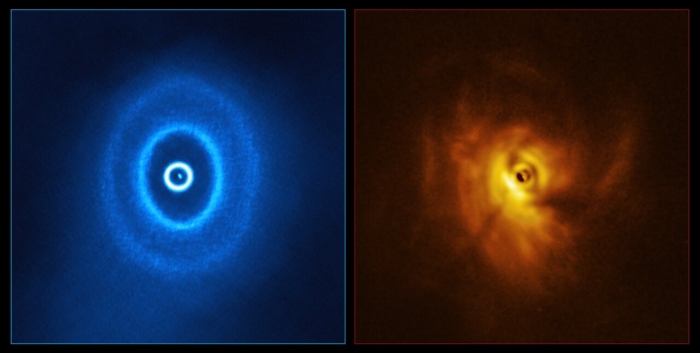A cloud of dust and gas swirling around an infant star system 1,300 light-years away is like no planet-forming disc we've seen yet. It consists of three rings, wrapped around three stars - and all three rings have different orientations, with the innermost wildly misaligned from the other two.
It's the first direct evidence that such misalignment - known as 'disc tearing', and predicted in modelling - can occur in the wild.
But, although the Atacama Large Millimeter-submillimeter Array (ALMA) has performed the most detailed observation of the system yet, it's still unclear exactly how the disc-tearing occurred.
The system, named GW Orionis, is located about 1,300 light-years away, in the constellation of Orion. It consists of two stars, locked in orbit around each other at a distance of roughly one astronomical unit (the average distance between Earth and the Sun), with a third star orbiting the pair on a misaligned orbit at a distance of eight astronomical units.
Around all three stars, the giant protoplanetary cloud of dust and gas churns, with the rings at distances of 46, 185, and 340 astronomical units from the centre of the system.
That outer ring is the largest we've ever seen in a protoplanetary system; for comparison, Pluto's average distance from the Sun is 39.5 astronomical units.
Protoplanetary discs, as the name suggests, are the material from which planets form around a star. First, the star needs to form and grow in a stellar nursery. A knot of material in a protostellar cloud gravitationally collapses, and starts to spin. This spools a giant disc of gas and dust that feeds into the growing star.
When this formation process is complete, the leftover material in the disc starts to clump together and eventually forms planets and other minor bodies. That's why, in planetary systems like our Solar System, the planets and rock belts are aligned more-or-less along a flat plane, circling the star's equator.
Around systems of multiple stars, however, the planetary plane is often misaligned with the orbits of its stars. Studying the protoplanetary discs around multiple star systems can help us understand how this misalignment happens.
The strange misalignment in the protoplanetary disc in GW Orionis was first discovered in ALMA observations in 2017.
 ALMA observation (left) and VLT (right). (ALMA (ESO/NAOJ/NRAO), ESO/Exeter/Kraus et al.)
ALMA observation (left) and VLT (right). (ALMA (ESO/NAOJ/NRAO), ESO/Exeter/Kraus et al.)
"We were surprised to see the strong misalignment of the inner ring," said astronomer Jiaqing Bi of the University of Victoria in Canada. "But the strange warp in the disk is confirmed by a twisted pattern that ALMA measured in the gas of the disc."
A second team of astronomers also took closer observations, using both ALMA and the European Southern Observatory's Very Large Telescope.
"In our images, we see the shadow of the inner ring on the outer disk," said astronomer Stefan Kraus of the University of Exeter in the UK.
"At the same time, ALMA allowed us to measure the precise shape of the ring that casts the shadow. Combining this information allows us to derive the three-dimensional orientation of the misaligned ring and of the warped disk surface."
Luckily, although the misalignment was only discovered recently, GW Orionis has been monitored since 2008, and the third star in the system was discovered in 2011. That gave the researchers several years of data from which to reconstruct the orbits of the system.
Using 3D computer simulations of the system, Kraus and his team found that the conflicting gravitational influences of the stars along different planes was able to produce the pronounced disc tearing seen in GW Orionis.
But Bi and his team found that the gravitational effect of the stars' orbital shenanigans isn't enough on its own to result in the observed rings.
"Our simulations show that the gravitational pull from the triple stars alone cannot explain the observed large misalignment. We think that the presence of a planet between these rings is needed to explain why the disk was torn apart," said astronomer Nienke van der Marel of the University of Victoria.
"This planet has likely carved a dust gap and broken the disk at the location of the current inner and outer rings."
If there was such a planet, it would be the first we'd ever found orbiting three stars - but of course, it's way too early to make such a claim. Future observations of the system are in the pipeline to try and solve this fascinating puzzle.
The research has been published in The Astrophysical Journal Letters and Science.
#Space | https://sciencespies.com/space/orion-hosts-a-bizarrely-wonky-protoplanetary-system-with-3-stars/
No comments:
Post a Comment